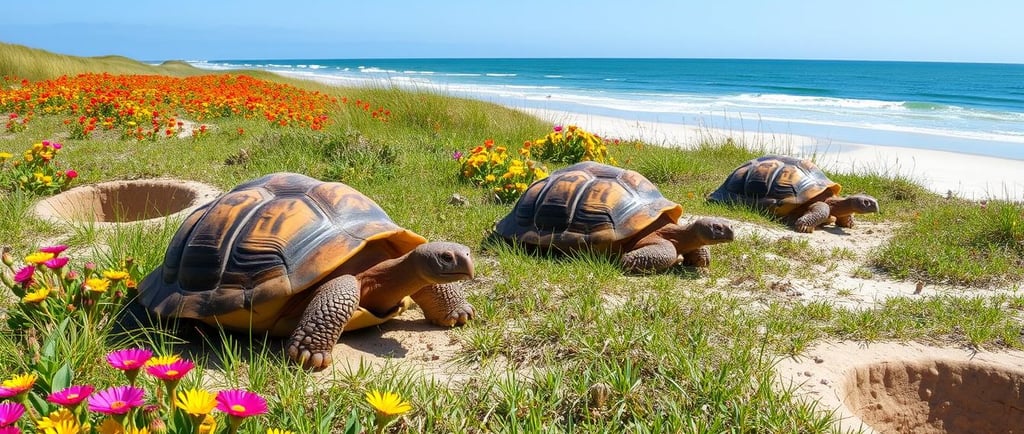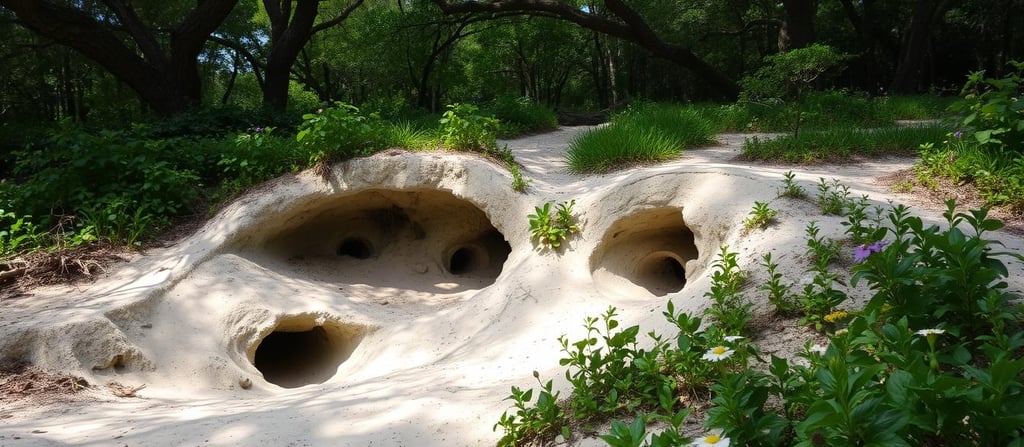Gopher Tortoises: Guardians of The Nature Coast
Imagine a creature that has lasted for nearly 2 million years. It has seen the end of dire wolves and 500-pound armadillos in Florida. Gopher tortoises are the true guardians of the Nature Coast.
WILDLIFEFLORIDA'S NATURE COASTENVIRONMENTAL


Imagine a creature that has lasted for nearly 2 million years. It has seen the end of dire wolves and 500-pound armadillos in Florida. Gopher tortoises are the true guardians of the Nature Coast. They play a key role in keeping the ecosystems balanced.
Gopher tortoises have been burrowing for millions of years. Their tunnels can go up to 40 feet deep. These tunnels protect them from fire, predators, and harsh weather. They have survived where many others have not.
But their role goes beyond just survival. They are a keystone species. Over 360 other creatures depend on their burrows for shelter, food, and safety.
Key Takeaways
Gopher tortoises have endured for nearly 2 million years, outlasting many other species
Their elaborate burrows, up to 40 feet deep, provide crucial shelter and protection
As a keystone species, gopher tortoises support over 360 other creatures in their ecosystem
Habitat loss and urban development threaten these ancient guardians of the Nature Coast
Conservation efforts are essential to protect gopher tortoises and the biodiversity they sustain
Ancient Survivors of Florida's Changing Landscape
The gopher tortoise has lived in Florida for nearly 2 million years. These turtles have seen big changes in the environment. They have adapted to survive through extreme weather and the loss of big animals.
The 2-Million-Year Legacy
Fossils show gopher tortoises have been in Florida since the Pleistocene Epoch, over 2 million years ago. Florida's landscape has changed a lot, from coastal plains to forests and wetlands. Yet, the gopher tortoise has kept going, showing amazing adaptability.
Adaptation Through the Ages
The gopher tortoise has learned to survive by digging deep burrows. These burrows help them avoid extreme temperatures and find safety during droughts or floods. They also eat a variety of plants, helping them live in different habitats.
Historical Habitat Range
Once, gopher tortoises lived in a much bigger area, almost three times the size of Florida today. This shows how resilient and adaptable they were. But, habitat loss has made them endangered in many parts of the southeastern United States.
Statistic Value Estimated annual survivorship of head-started gopher tortoises (first cohort) 60.6% Annual survivorship of head-started gopher tortoises (second cohort) Varied significantly: 7.1% at southeast release area, 75.0% at northwest release area Maximum distance moved by released head-started tortoises 122.0 meters Annual survivorship of wild hatchlings 12.8% Fate of 85 hatchlings in previous studies All died within 2 years of release Average age of sexual maturity for head-started tortoises 14.4 years
The gopher tortoise's ability to survive for millions of years is remarkable. They have seen Florida change a lot. But, their future is uncertain because of habitat loss and fragmentation. These endangered terrestrial turtles face big challenges.
Gopher Tortoises: Masters of Underground Architecture
Gopher tortoises are amazing at digging underground homes. These homes can be up to 65 feet long and 26 feet deep. They offer a safe place from the weather and predators.
Their burrows have a unique half-circle entrance. Inside, there's a big chamber where they spend most of their time. This burrow not only protects the tortoise but also helps the nature coast turtles ecosystem. The digging brings up soil that's good for plants to grow.
But, moving gopher tortoises because of development is hard. They have to leave their homes and try to go back. This is stressful and dangerous for them. Efforts to save them focus on keeping their burrows safe and creating new homes.
Key Facts about Gopher Tortoise Burrows Up to 65 feet long and 26 feet deep Half-circle shaped entrance Roomy end chamber for the tortoise Bring nutrient-rich soil to the surface Provide shelter for over 350 other species
Gopher tortoises are experts at building underground homes. Their burrows not only protect them but also help the tortoise relocation ecosystem. It's important to save these amazing creatures and their homes for Florida's natural balance.
The Keystone Species Effect
Gopher tortoises are more than just fascinating reptiles. They are crucial keystone species, vital for Florida's diverse ecosystems. Their burrows shelter over 360 different animal species, including reptiles, amphibians, mammals, and insects. Some, like the gopher cricket, are found nowhere else on Earth, making their presence critical for habitat conservation.
Supporting Over 360 Species
Gopher tortoises spend up to 80% of their time in their burrows. These burrows can be as deep as nine feet and almost fifty feet long. They serve as a vital resource for many animals, offering shelter and nesting sites.
The presence of gopher tortoise burrows is essential for endangered species like indigo snakes and burrowing owls. They rely on these unique habitats for survival.
Ecosystem Engineering Impact
The gopher tortoise's influence goes beyond providing shelter. Their digging and grazing help maintain open, sunny areas. This is crucial for many plant species to thrive.
In longleaf pine forests, gopher tortoises are vital in fire ecology. Their burrows offer haven to animals during natural or controlled burns. These burns are essential for the health and regeneration of these unique habitats.
Role in Longleaf Pine Forests
The gopher tortoise's presence in longleaf pine ecosystems enhances biodiversity. They contribute to seed dispersal and soil aeration. Without them, the Southeastern United States ecosystem would face significant challenges.
Protecting the gopher tortoise and its burrows is essential. It safeguards the delicate balance of these remarkable longleaf pine ecosystems.
Conclusion
The gopher tortoise is a remarkable survivor in Florida's changing landscape. It faces big challenges like habitat loss and human activities. Saving them is key for their survival and the balance of ecosystems.
Efforts to save them include preserving habitats and creating wildlife corridors. It's also important to manage land responsibly. Public awareness and community help are crucial in protecting these tortoises and other species that rely on them.
Protecting gopher tortoise habitats ensures their future and the biodiversity of the Nature Coast. The survival of these tortoises is tied to Florida's natural wonders. Our actions today will impact the future for generations to come.
FAQ
How long have gopher tortoises been residents of Florida?
Gopher tortoises have lived in Florida for almost 2 million years. They have adapted to big changes in the landscape over time.
What role do gopher tortoises play in their ecosystems?
Gopher tortoises are very important in their ecosystems. Their burrows are homes for over 360 animal species. They also help with fire, seed spreading, and soil health, making their habitats more diverse.
How do gopher tortoises adapt to their environment?
Gopher tortoises are very resilient. They have adapted to extreme weather and the loss of big animals. Their deep burrows and varied diet help them survive.
What challenges do gopher tortoises face?
Gopher tortoises face big challenges like habitat loss and human activities. It's important to protect them and the animals that depend on them.
How can the public help protect gopher tortoises?
The public can help by raising awareness and getting involved. We can preserve habitats, create wildlife paths, and manage land responsibly.
Gopher Tortoises: Guardians of The Nature Coast



